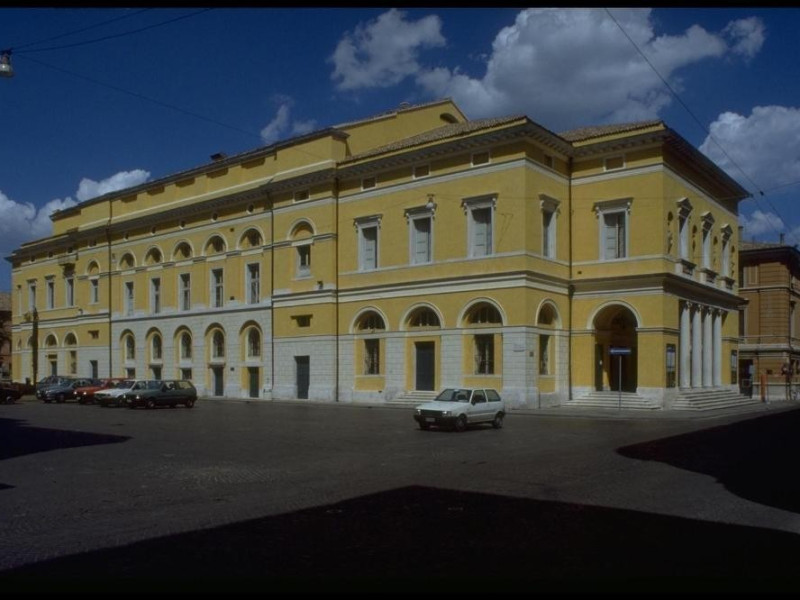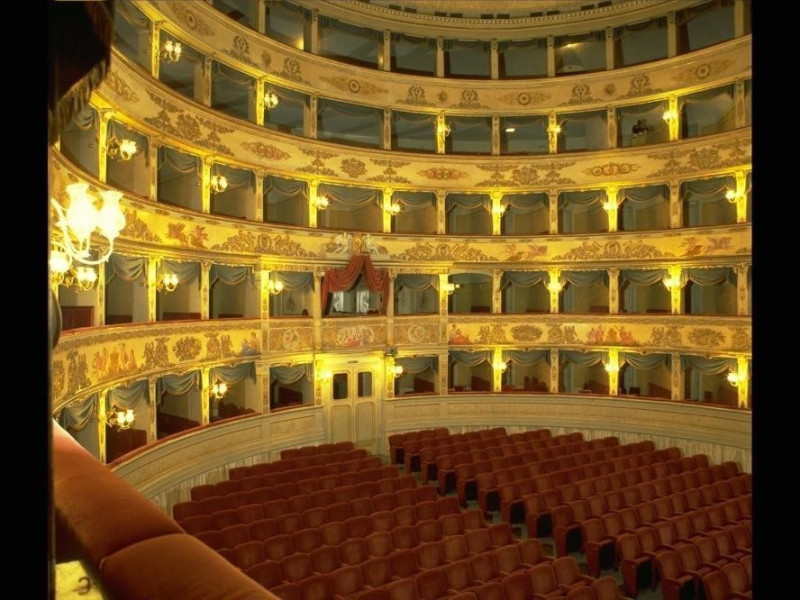Teatro Dante Alighieri
The city of Ravenna has a long tradition of theater and music, being far from the goal 'of the sixteenth century equipped with rooms used permanently, or for the occasion, a performance venues and are genuinely theatrical public. There are reports of the existence of a wooden stage for the "Chomedia", already in 1556, in the Hall of the Town Hall (now the Council Hall), where he continued his work in theater and music up to 1867 Several salons Apostolic Palace were periodically adjusted to public performances from 1615 to 1841 at the College of Nobles (active 1696-1877), which had a significant impact on the cultural, moral and political leadership of Ravenna, was built a large hall destined to the theater that took in height even the first floor of the building. In addition, in the courtyard of the College itself, was made an open air theater with "pavilions", ie large tents for mobile coverage. The latest news regarding the use of the premises of this building is 1812 Following the demolition, in 1702, the stage in the Hall of the Palazzo Comunale, it was decided to build a new public theater: Theatre Comunitativo. In charge of the design was the architect Giacomo Ravenna Elderly (1684-1736). In 1723 the building was finished external walls; a year later he was also completed internally counted 97 stages divided into four orders. The elegant theater, baroque appearance, was extended from 1779 to 1782 Closed in 1857, the building was used for other purposes. Another city theater, the Teatro Bertoldi, was built in 1846 and opened the following year. Consisting of stalls, two tiers of boxes in the back wall and two side galleries leaned toward the stage, were annexed to the tavern and coffee. Since 1867, passed in the Academy Filodrammatica management. The performances came to an end May 29, 1887; in 1890 it was demolished and replaced by civil construction. Gaetano Patuelli beginning in 1863 the construction of a theater consists of two tiers of boxes and a gallery divided into boxes; audience for meta 'occupied by stalls, half' free for the public standing. In 1877, during the administration Graziani, will be entitled to Angelo Mariani. After a long series of restorations and renovations, in 1929 it was decided to end it. Only in 1948, the building will be entirely rebuilt, becoming a movie theater, as it had been in 1896 with the first projections of the Lumiere Cinema. Following the request of the Academy Filodrammatica the granting of the building of the former Church of St. Clare, was erected at Ravenna Teatro Filodrammatico: although incomplete, was inaugurated in 1892 The audience was provided with an inclined plane; The tunnel, completed in 1893, consisted of a central body and two lateral extensions, supported by columns and iron shelves. In 1919 the theater was named after countryman Luigi Rasi and continued his activities until 1938 and then remained closed until, in 1962, proposed to the municipal administration to face a radical transformation of the building: thus began a long dispute was resolved in 1970 Currently the Teatro Rasi, intended for theatrical activities alternatives, assumed an aspect of cinema consists of wide audience, gallery and stage of limited size. But the theatrical structure more representative of the city is without a doubt the Teatro Alighieri, active from about 1852 to 1830 the civic administration started the research and design of an architectural solution that would satisfy the interests of Ravenna for the theater, given the 'insufficiency of existing structures. The task was entrusted to Ignazio Sarti, since 1827 director of the Academy of Fine Arts, which worked out a renovation project of the old Theatre Comunitativo which provided an extension to the current square Einaudi. Was not carried out for various reasons, including those of urban order. He was then appointed in 1838 a council committee with a mandate to investigate and compile a proposal for the erection of a new theater. After examining the report, the task of the project was entrusted to the architect Tommaso Meduna, who had rebuilt the interior of the Teatro la Fenice in Venice. Presented the project in July, 1839, controversy arose, so in 1840 the brothers Giovan Battista and Tommaso Meduna introduced a new project to date and reduced in accordance with the changes suggested also by the Town Council. In the same year began the work, which included the demolition of old houses nearby and saw changed the orientation of the façade, provided first to the Palace of the Treasury (now the Palazzo della Posta), then in front of today's street Mariani. The work dragged on longer than expected, so much so that in 1852, to cover the expense, were also sold the antlers of the fourth order. The paintings and decorations of the auditorium, as well as the atrium, casino and adjacent rooms were the work of Venetian painters Giuseppe Voltan and Giuseppe Lorenzo Gatteri; decorations applied Gentle engraver; gilding Carlo Franco: all Venetians chosen by Meduna. The decor and, in some cases, the interior decoration of the boxes were entrusted to the individual owners. In the large space above the ceiling of the auditorium was restored in the room to paint the scene. The solemn inauguration took place May 15, 1852 with Meyerbeer's Robert the Devil and the Medea of Pacini, as well as two dances, one heroic, the other half of character: The Gypsy and The fake sleepwalking. On the morning of the same day, the apostolic delegate Stefano Rossi proposed the naming in Teatro Dante Alighieri. The facade consists of a portico projecting from the body of the building and floor of five steps from the plane of the road. It consists in the lower register of five intercolumni on which the upper floor, there are three windows trabeated. Under the porch, laterally to the three inputs are obtained the ticket. The entrance hall, with richly decorated ceiling, is equipped with Ionic columns: there are complementary access to lounges, designed to wardrobe and the smoking room, the stairway to the overlying reduced and the entrances to the hall and to the boxes. The audience, a horseshoe, is composed of four rows of twenty-three stages each, plus a gallery with parapettate continuous and decorated with figures, animals and floral motifs. The seven central boxes of the fourth order are reduced to the gallery. The stage of honor of the second order, with balcony convex, it is decorated on either side by Corinthian columns and topped by curtains. Even the ceiling is richly decorated with floral motifs and female figures. From the central rosette chandelier hangs while the boxes are lit by lanterns liberty. The orchestra pit is separated from the audience by a wooden balustrade. The vast stage jutting is equipped with dressing rooms and service rooms. The original curtain was painted by the Venetian painter Giovanni Busato and depicting the entrance of Theodoric in Ravenna. The bedside table, with the apotheosis of Dante was the work of Sebastiano Sarti Murano. The theater Alighieri is characterized by a tremendous amount of restoration, consolidation and restructuring in which it has been subjected throughout this century. In 1906, amid great controversy, was installed the first electric light. In 1919, the restorations were made to the decorations of the ceiling of the atrium to the work of Enrico Piazza. In 1925 they were redone the floors of the Casino and adjacent areas. A first major restoration of the theater was implemented between the years 1929 and 1931, a period when it was built a new building to house dressing rooms behind the stage and a gallery was built at the fourth order, instead of the nine central boxes. The stage was decorated with the retaining wall of the limelight and was lowered to the floor to create the orchestra pit. They built the toilets and the coffee was moved to the first floor. The curtain was replaced and the stage direction was expanded. The electrical systems were rebuilt and built a new, modern heating system. After thirty years, the theater was closed and declared unfit for the presence of dangerous pests in wooden structures. From 1959 to 1967 are carried out restoration work on roofing, replacing the damaged beams with composite steel-roofing and masonry. The floor of the Concessions is replaced, consolidated the back wall of the stage and turned down the supporting pillars in masonry, flooring and renovated all coatings including stairways of the galleries and the dressing rooms. It was restored and reduced the hall of Plataea and painted the exterior. The plumbing was redone wiring systems. They created tunnels to mount the pipes of electric and other passages to fit the piping of air conditioning systems. It was created on safety curtain. Replace the seats in the gallery and in the audience, the furniture, the curtains and curtain. Between 1991 and 1993 in the Theatre were carried out substantial work to comply with new safety standards. Below are listed the most significant: the remaking of the electrical system, with an undercurrent restructuring, both in the area reserved for artists, and that of the public; and a reclamation consisting in the removal of the plaster containing asbestos fibers that covered the metal trusses of the roof area of the stage. After the complete restoration of the environment have been applied to increase protection of the fire resistance of the trusses concerned. And also, a lightning protection system, and a smoke detection and intrusion; the reclassification of thermal plants with a review of those for ventilation or air conditioning, as a result of adaptation to fire regulations. Then followed other interventions for the redeployment of tanks to ensure a rapid flow of water in case of fire. The premises intended for artistic personnel have been renovated with new furniture and new toilets. An extraordinary maintenance was carried out to adjust private baths to the public with current sanitary regulations. The walls were renovated by replacing the moisture ruined plaster with plaster-based air-entraining hydraulic lime and earthenware on the outside, while the walls were painted with painting interested in lime. Today the theater Alighieri performs regular concerts, theater and opera. (Nadia Ceroni / Catherine Sword)






